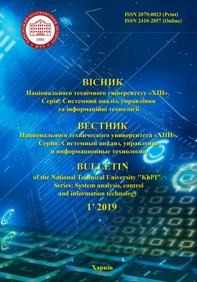MODELS AND SOFTWARE SOLUTIONS FOR THE PROBLEM OF DIAGNOSING THE FINANCIAL STATE OF IT ENTERPRISE
DOI:
https://doi.org/10.20998/2079-0023.2019.01.06Keywords:
diagnosing, financial state, financial indicator, fuzzy logic, production model, Mamdani algorithm, rule baseAbstract
Today, the economy of Ukraine is in a relatively unstable position; therefore, Ukrainian enterprises require effective management. But in order to effectively manage the enterprise, you need to know what state it is in. Solving the problem of diagnosing the financial state of an enterprise in the future will allow developing an apparatus of effective management decisions that will help maintain the enterprise at the proper level of functioning and ensure further development of both the enterprises and the economy as a whole. The relevance of research is manifested in the application of the results for operational and effective management. The problem is in the need to obtain a more accurate solution for the problem of diagnosing the financial state of the enterprise with the parameters that characterize the financial situation best of all. The main objective of the research was to solve the problem of diagnosing the financial state of an IT company, using a model that implements a certain approach in order to obtain a qualitative conclusion about the state of a company. A method based on the use of a fuzzy logic apparatus, namely, production models with a Mamdani fuzzy inference algorithm is proposed for solving the problem. There are 10 input parameters were allocated to determine the financial state. The criteria according to which the state was assessed were quantitative and qualitative indicators of the company’s activity over the selected period. The resulting mathematical model allows to take into consideration both quantitative and qualitative indicators. The results of the research give an understanding of what indicators and how affect the financial condition of the company, and can also be used in the future, for example, to solve the forecasting problem. The implementation of research results can help speed up the diagnosis of the financial state of the enterprise and make a right management decision based on the results of diagnosis in time.References
N. D. Egupov, ed. Metody robastnogo, neyro-nechetkogo i adaptivnogo upravleniya. Uchebnik [Methods of robust, neuro-fuzzy and adaptive control: Tutorial]. 2-e izd. Moscow, MGTU im N. E. Baumana Publ., 2002. 744 p.
Rusak N. A., Rusak V. A. Diagnostika finansovogo sostoyaniya predpriyatiya [Diagnostics of the financial condition of the company]. Trud i sotsial'nye otnosheniya [Labor and social relations]. Moscow, ATISO Publ., 2012, no 9, pp. 120–126.
Stoyanov E. A., Stoyanova E. S. Ekspertnaya diagnostika i audit finansovo-khozyaystvennogo polozheniya predpriyatiya [Expert diagnostics and audit of the financial and economic situation of the enterprise]. Moscow, Perspektiva Publ., 1993. 89 p.
Kovalev A. P. Diagnostika bankrotstva [Диагностика банкротства]. Moscow, AO "Finstatinform" Publ., 1995. 96 p.
Plyshevskiy B. P. Finansovoe polozhenie: novye tendentsii [Financial situation: new trends]. Finansy [Finances]. Moscow, "Knizhnaya redaktsiya finansy" Publ., 2003, no 2, pp. 18–20.
Rotshteyn A. P. Intellektual'nye tekhnologii identifikatsii: nechetkie mnozhestva, geneticheskie algoritmy, neyronnye seti [Intellectual identification technologies: fuzzy sets, genetic algorithms, neural networks]. Vinnitsa, Universum-Vinnytsya Publ., 1999. 320 p.
Orlov A. I. Nechislovaya statistika [Non-numeric statistics]. Moscow, MZ-Press Publ., 2004. 513 p.
Samarskiy A. A., Mikhaylov A. P. Matematicheskoe modelirovanie. Idei. Metody. Primery [Math modeling. Ideas. Methods. Examples]. 2-e izd. Moscow, Fizmatlit Publ., 2001. 320 p.
Matviychuk A. V., Smetanyuk O. A. Diagnostirovanie finansovogo sostoyaniya predpriyatiya s primeneniem instrumentariya nechetkoy logiki [Diagnosing the financial condition of an enterprise using fuzzy logic tools]. Finansy Ukrayiny [Finance of Ukraine]. Kiev, SAI "Academy of Financial Management" Publ., 2007, no 12, pp. 115–128.
Shtovba S. D. Vvedenie v teoriyu nechetkikh mnozhestv i nechetkuyu logiku [Introduction to the theory of fuzzy sets and fuzzy logic]. Available at: http://matlab.exponenta.ru/fuzzylogic/book1/index.php (accessed 20.01.2013).
Matviychuk A. V. Analiz ta prohnozuvannya rozvytku finansovo-ekonomichnykh system iz vykorystannyam teoriyi nechitkoyi lohiky [Analysis and forecasting of the development of financial and economic systems using the theory of fuzzy logic]. Kiev, Tsentr navchal'noyi literatury Publ., 2005. 183 p.
Borisov V. V., Kruglov V. V., Fedulov A. S. Nechetkie modeli i seti [Fuzzy models and networks]. 2-e izd. Moscow, Goryachaya liniya–Telekom Publ., 2012. 284 p.
Downloads
Published
How to Cite
Issue
Section
License
Copyright (c) 2019 Bulletin of the National Technical University "KhPI". Series: System analysis, control and information technologyAuthors who publish with this journal agree to the following terms:
- Authors retain copyright and grant the journal right of first publication with the work simultaneously licensed under a Creative Commons Attribution License that allows others to share the work with an acknowledgement of the work's authorship and initial publication in this journal.
- Authors are able to enter into separate, additional contractual arrangements for the non-exclusive distribution of the journal's published version of the work (e.g., post it to an institutional repository or publish it in a book), with an acknowledgement of its initial publication in this journal.
- Authors are permitted and encouraged to post their work online (e.g., in institutional repositories or on their website) prior to and during the submission process, as it can lead to productive exchanges, as well as earlier and greater citation of published work (See The Effect of Open Access).


